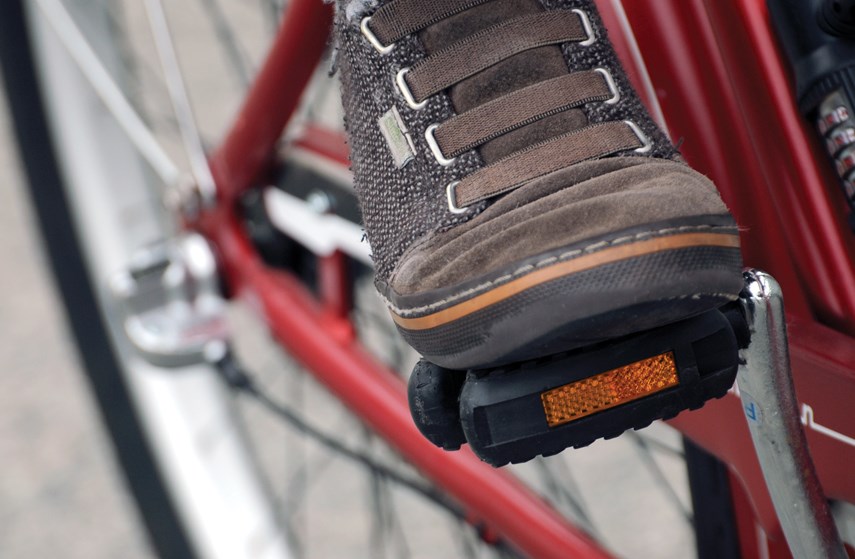If you have a functioning drivetrain and tires full of air, the three next most important parts of a bike are the seat (known as a saddle), the handlebars and the pedals.
After all, these are the parts that you touch! Today’s column will focus on pedals.
Do you think that pedals are simple, flat pieces of plastic or metal, with no actual technical cachet or features? Hah! Can you identify three kinds of pedals? We at Pedal Pushers are here to help by explaining each kind of pedal, all intended for the same basic purpose: er, moving the bike. But each has a special use and of course a special place in our hearts.
First there’s the ubiquitous basic plastic or metal flat pedal with no bells and whistles, except those hard-working ball bearings inside them. We are talking just your plain old econobox kind of pedal which usually comes with your reasonably priced bike. They are all you really need. Basic flat – also called platform – pedals are perfectly adequate and hardly ever complain when you drop them on the ground or stand up on them to get up that hill. If you ride your bike a few flat(ish) blocks to get to the rec center for yoga class, then these work perfectly fine. The nice thing about plastic pedals is that when they hit you in the calf or shin, they barely make a mark. Flat pedals work with flip flops, steel toed boots and everything in between.
A great and cheap upgrade to flat pedals is to add toe straps and they come in different colors. If you can figure out how to install them. Toe straps are kind of awkward at first, but you’ll get used to them in a bit and they are totally worth the effort. Slip your patent leather pumps or brogues into the strap and your feet become part of the bike. Your feet don’t slip off the pedals and from an efficiency point of view, you can get power to the pedal when your foot is moving up, not just down. Two strokes for one! Well, it’s not exactly double the efficiency, but you get the picture.
People (pedal makers, perhaps) say that plastic pedals deform a tiny bit each time you pedal and the deformation contributes to sore feet. This thinking seems a bit obsessive, but it could be true if you ride a lot and don’t wear hard-soled shoes. Over time, plastic pedals will degrade, chip and generally scuff up, ruining your image! This is the opportunity to “upgrade.” Put your “pedal to the metal” and get metal flat pedals. Metal pedals will generally outlast plastic and provide a more “stable” platform. But beware: metal flat pedals are more apt to bite your shins and calves and scratch whatever they lean against, like your car.
A favourite of cyclists on the North Shore are flat platform pedals with grippy “pins” to keep your shoes in place. These wide-base pedals are metal or nylon and were developed for mountain biking. It turns out they also work well in torrential winter rains when regular flat pedals without pins feel as slippery as a mossy boardwalk.
If you have the money, some Pedal Pushers prefer “clipless” pedals. It’s a real head scratcher, but what the industry calls clipless pedals are the ones you actually “clip” your feet into. Weirdos. I guess they went to product design school and didn’t learn basic English. “Clipless” pedals are good for long distances when your goal is to “get there and back” with only a few walking stops along the way, because the metal cleats on the bottom of your shoes aren’t good for walking. Just be aware, if you stop and forget to unclip, you fall over, like in a bad Monty Python skit (ask us how we know…). They come at a cost, too. A basic set of “clipless” pedals will cost you $100. Plus you need the special shoes that are adaptable to the clips on the clipless pedals. Those are $150+. A used bike could be cheaper than pedals!
After a brief survey one afternoon, the foot fetish Pedal Pushers have determined (scientifically) that the “proper” pedal/shoe combo in North Vancouver is flat mountain bike style pedals with pins and Blundstone boots. The pedals are larger and “stickier” than standard pedals. The boots are waterproof, warm in winter, and indestructible. That’s not fake news.
The North Shore Pedal Pushers are Heather Drugge and Antje Wahl. The guy who makes the column readable, Dan Campbell, prefers driving. See – we can all work together.



